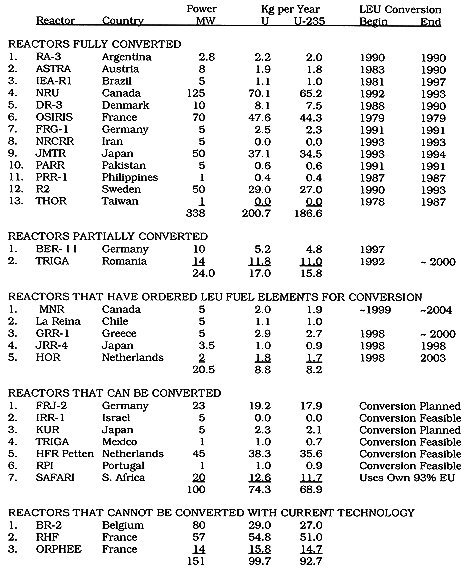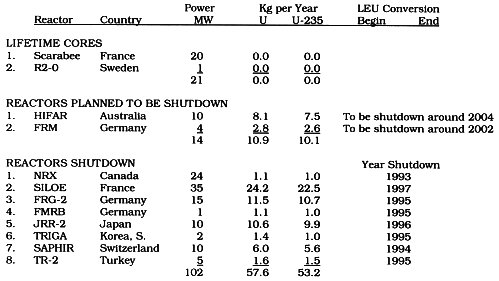
RELATIONSHIP BETWEEN THE RERTR PROGRAM
AND THE U.S. SPENT FUEL ACCEPTANCE POLICY
J.E. Matos
RERTR Program
Argonne National Laboratory
9700 S. Cass Avenue, Bldg. 207
Argonne, IL 60439-4841
ABSTRACT
In order to reduce the danger of nuclear weapons proliferation posed by use of highly enriched uranium (HEU, ³ 20%) in the fuel of research and test reactors, the United States adopted three closely linked policies and programs: U.S. policy and laws regarding export of HEU, the Reduced Enrichment for Research and Test Reactors (RERTR) Program, and the Spent Fuel Acceptance Policy. These policies and programs address the entire fuel cycle for research and test reactors using HEU of U.S. origin. Together, they serve to implement the U.S. policy objective of minimizing and eventually eliminating the use of HEU in civil programs worldwide. This paper discusses some of the history and relationships among these programs.
INTRODUCTON
The United States has engaged in cooperative activities on nuclear technology with many countries since the "Atoms for Peace" Program was initiated in the 1950s. As part of this nuclear cooperation, the United States provided HEU for use as fuel in research reactors around the world. Although HEU could be used in nuclear weapons, HEU was provided to these countries as part of an arrangement under which countries agreed to forego development of nuclear weapons if the United States would assist them in peaceful applications of nuclear technologies. As a result of successful implementation of these arrangements during the 1960s and 1970s, HEU became widely available and was used in some research and reactors even though LEU fuel would have sufficed to meet the reactors’ performance needs.
In the 1970s, a nuclear explosion in India, unsafeguarded nuclear activities in other countries, and growing terrorist activities caused grave concerns about nuclear proliferation. Among these concerns was the high level (Figure 1) of U.S. HEU exports, most of which was used to fuel research and test reactors. Between 1970 and 1977, for example, an average of over 1100 kg of HEU were exported per year. The need to continue usage of HEU in research and test reactors was questioned by the U.S. Congress and by a number of U.S. government agencies. In 1977, the International Nuclear Fuel Cycle Evaluation (INFCE) recommended that research reactors convert to LEU fuel. In 1978, DOE established the RERTR Program to develop the technical means to convert research and test reactors from the use of HEU fuels to the use of LEU fuels. At the same time, Executive Branch agencies and the Nuclear Regulatory Commission instituted stringent procedures to review export license applications for HEU.

Figure 1. HEU Exports by Year
HEU EXPORT RESTRICTIONS
In addition to other requirements of the U.S. Atomic Energy Act of
1954, the Schumer
amendment[1] to the Energy Policy Act of 1992 places the further restrictions
on HEU exports. The new restrictions state that the Nuclear Regulatory Commission may
issue a license for the export of highly enriched uranium to be used as a fuel or target
in a nuclear research or test reactor only if, in addition to any other requirement of
this Act, the Commission determines that:
As used in this section:
As of January 1998, there have been no new exports of HEU approved by the NRC for use in research reactor fuel or targets since the Energy Policy Act became law in October 1992.
RERTR PROGRAM
The RERTR Program has been a key element in providing the technical means to implement U.S. nonproliferation policy regarding HEU. Most of the HEU utilized in civil nuclear programs is used in research reactor fuel or in radioisotope production targets. If LEU fuels can be substituted for HEU fuels and targets in the research reactors, then weapons-usable uranium can be virtually eliminated from the fuel cycle. RERTR Program accomplishments include developing and qualifying LEU fuels that can be used in 90% of the research reactors using HEU of U.S. origin, encouraging and assisting fuel suppliers in twelve countries to manufacture LEU fuels, and assisting reactor operators in performing design and safety analyses for conversion of their reactors.
Table I summarizes the LEU conversion status as of January 1998 for the 42 foreign research reactors with power levels ³ 1 MW that use HEU of US or other western origin. Previous conversion summaries as of 1994 and 1996 were provided in Refs. 2 and 3. To date, 20 operating research reactors in 17 countries have completed LEU conversion or have ordered the LEU fuel to begin the conversion process. Two converted foreign reactors have since shutdown. In the United States, nine university research reactors have completed conversion, one reactor is scheduled to receive its LEU fuel in April 1998, and seven reactors are in different stages of the conversion process. Suitable LEU fuel is not currently available for four of the six U.S. government reactors with power ³ 1 MW that use HEU fuel. Conversion of one DOE reactor is planned and conversion of one DOE reactor is feasible. Additional information on the conversion status of U.S. research reactors can be found in Ref. 4.
Table I. Conversion Status of Foreign Research and Test Reactors with
Power ³ 1
MW Using HEU of United States Origin as of January 1998


Table II lists the new research reactors with power ³ 1 MW that began construction after 1978 and use or plan to use LEU fuels developed by the RERTR Program and its international partners. These reactors almost certainly would have been fueled with HEU if suitable LEU fuels were not available. The only exception among western reactors is the FRM-II reactor in Germany, which was designed to use HEU fuel, even though it has been shown[5] that the reactor could meet all of its performance and scientific goals using LEU fuel.
Table II. Research Reactor with Power ³ 1 MW
Using LEU Fuel that Began
Construction After the RERTR Program was Initiated in 1978

A more detailed description of RERTR Program accomplishments and development plans are provided in Ref. 6. The major activities during the current year include: (1) continue development of advanced LEU fuels with very high uranium densities, irradiation of microplates containing these fuels in the Advanced Test Reactor (ATR) in Idaho, and post-irradiation examinations at Argonne-East; (2) continue development of LEU targets and chemical processing methods for production of Mo-99; (3) continue collaboration with the Russian RERTR Program on the fuel development, fuel testing, and reactor analyses that are needed for LEU conversion of Russian-supplied research and test reactors; (4) continue LEU conversion studies for U.S. supplied research and test reactors.
OFFSITE FUELS POLICY
The U.S. began accepting HEU spent fuel from foreign research and test reactors in 1958. However, the Offsite Fuels Policy under which this same fuel was accepted began in 1968. The terms and conditions for services related to receipt and financial settlement for nuclear research reactor fuels were first set forth by DOE in a Federal Register Notice entitled "Spent Fuel: Chemical Processing and Conversion"[7], which was published in January 1968. This Notice was subsequently amended nine times[8-16]. The policy expired on December 31, 1988 for HEU fuels and on December 31, 1992 for LEU fuels.
Early in the RERTR Program (~1980), foreign reactor operators stated clearly that they would not be allowed to use the new LEU fuels being developed under the RERTR Program unless there was a guaranteed means of disposal of the spent fuel. At that time, it meant that the fuel needed to be reprocessible in order to close the fuel cycle. To establish the feasibility of reprocessing LEU aluminide, oxide, and silicide fuels, miniature fuel plates manufactured by the RERTR Program at Argonne National Laboratory were irradiated in the Oak Ridge Research Reactor, and investigated at the then Savannah River Laboratory. The conclusion of these investigations[17,18] was that it was feasible to reprocess at the Savannah River Plant all of the RERTR LEU fuels being developed at that time (1983).
At the same time, foreign research reactors were under pressure, through U.S. export controls on HEU, to convert their reactors to LEU fuel. The reactors needed to irradiation test the new LEU fuels in their reactors before they could get licensing approval to convert. To obtain permission to insert the LEU fuel elements into the reactor for testing, a guaranteed means of disposal of the spent fuel was required by many licensing authorities. However, according to the U.S. Off-Site Fuels Policy in effect at that time[13], only HEU fuel could be returned to the U.S. Since conversions from HEU to LEU fuels were being encouraged by the U.S., foreign research reactor operators reasoned that the U.S. should amend its Off-Site Fuels Policy to include LEU fuel as well as HEU fuel. During this period, Argonne National Laboratory (with DOE’s consent) signed contracts with several European reactor operators to accept irradiated LEU prototype fuel elements until such time as DOE amended the Offsite Fuels Policy to include acceptance of LEU fuel. Progress in LEU conversions had in effect come to a halt because there was no spent fuel acceptance policy in the U.S. There were reactor operators who wanted to cooperate with US nonproliferation objectives on the front end of the fuel cycle, but were prevented from doing so by lack of a consistent U.S. policy on the back end of the fuel cycle.
For this reason, DOE amended[14,15] the Off-Site Fuels Policy in February 1986 to include acceptance of LEU aluminide, oxide, and silicide fuels until the end of 1992. The policy in effect for acceptance of HEU fuel was scheduled to expire on December 31, 1987, but was extended by one year to the end of 1988. The LEU fuel acceptance policy remained in effect until it expired on December 31, 1992.
Several years of discussions about renewal of the Offsite Fuels Policy ensued between DOE and foreign reactor operators and their governments. In July 1993, the Secretary of Energy directed that DOE prepare both an Environmental Assessment addressing short-term "urgent-relief shipments from selected foreign research reactors and a full environmental Impact Statement addressing all of the qualified spent research reactor fuel containing uranium of U.S. origin. The Environmental Assessment[2] was completed in April 1994 and the Environmental Impact Statement[3] was completed in February 1996.
SPENT FUEL ACCEPTANCE POLICY
On May 13, 1996 the Secretary of Energy signed the Record of Decision (ROD) on a Proposed Nuclear Weapons Nonproliferation Policy Concerning Foreign Research Reactor Spent Nuclear Fuel. Under this policy DOE will accept for thirteen years aluminum-based and TRIGA spent fuel assemblies that completed their irradiation within ten years after the ROD became effective. This ten year period allows reactor operators, their governments, and perhaps international organizations time to address solutions for managing their spent fuel after DOE’s Spent Fuel Acceptance Policy expires. DOE has stated that it does not intend to renew this policy.
The status of implementation of the program is described in several papers in this session and in other forums[19-21]. As of October 1997, four shipments[21] consisting of 822 fuel assemblies containing about 138 kg HEU and about 106 kg LEU had been received from nine countries by the Savannah River Site under the ROD. Preparations are in progress for six possible shipments to the Savannah River Site and one shipment to Idaho during 1998.
CONCLUSION
The RERTR Program, U.S. export policy regarding highly enriched uranium (HEU), the Offsite Fuels Policy, and now the Spent Fuel Acceptance Policy have been complimentary and closely linked programs since the inception of the RERTR Program in 1978. In addition, the Schumer amendment to the Energy Policy Act of 1992 places further restriction on HEU exports. Together, these policies, programs, and law have resulted in significant progress toward the U.S. policy objective of minimizing and eventually eliminating the use of HEU in civil programs worldwide.
REFERENCES